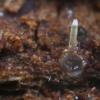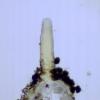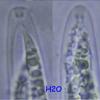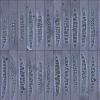
21-12-2025 09:32
Hello.A tiny ascomycete found embedded in wood in

20-12-2025 23:08
Patrice TANCHAUDBonsoir, récolte sur sol sablonneux dans l'arri�

20-12-2025 15:47
Mirek GrycHi.These grew on pine wood that was heavily covere

18-12-2025 21:17
Pol DebaenstThe identification took me to Byssonectria deformi

15-12-2025 07:09
 Danny Newman
Danny Newman
indet. Rutstroemiaceae sp. on unk. fallen leavesMc

19-12-2025 10:10
Patrice TANCHAUDBonjour, récolte réalisée en milieu dunaire, a

18-12-2025 17:23
 Bruno Coué
Bruno Coué
Bonjour,je serais heureux d'avoir votre avis sur c

18-12-2025 18:07
Margot en Geert VullingsThese plumes were found on rotten wood.They strong
Encontré estos peritecios hialinos inmersos, de 400 x 380 µm y cuello de 490 x 115 µm, emergiendo solo el cuello, en ramas de Prunus lusitanica ssp. Hixa. Ascas con anillo apical refractivo, IKI negativo pero bien visible en Rojo Congo o Floxina. Esporas de 34,5-41,6 x 4-4,9 µm, Me = 39,1 x 4,5 µm, septadas, la mayoría aparentemente con 7 septos, cuya morfología recuerda a conidios de Fusarium. Pienso que es una especie muy similar a Conioscyphascus varius (o Conioscypha varia ??) pero me gustaría conocer la opinión de alguien que conozca este hongo.
Gracias.
Rubén Negrín

very interesting and nicely illustrated post. Thanks for sharing your notes with us.
I never encountered this fungus but it matches perfectly with the description of C. varius provided by Réblova & Seifert, which rarely happens!
Saludos,
Jacques
Thank you for presenting these very nice photos of Conioscyphascus varius on this forum! In particular the second and third photo showing the hyaline perithecium are great. It isn't easy to make such photos because of the soft and fragile fruit bodies largely hidden in the wood.
I firstly encountered the species a few years ago and that collection got its name thanks to Björn Wergen. Since then I have found it regularly especially on Fraxinus branches which were kept in a damp box for some time.
Conioscyphascus varius is the name under which the species was originally described by Réblová & Seifert (2004). The anamorph was earlier described under the name Conioscypha varius. The latter is the proper name since the adoption of the "one fungus, one name" principle.
Saludos,
rubén







